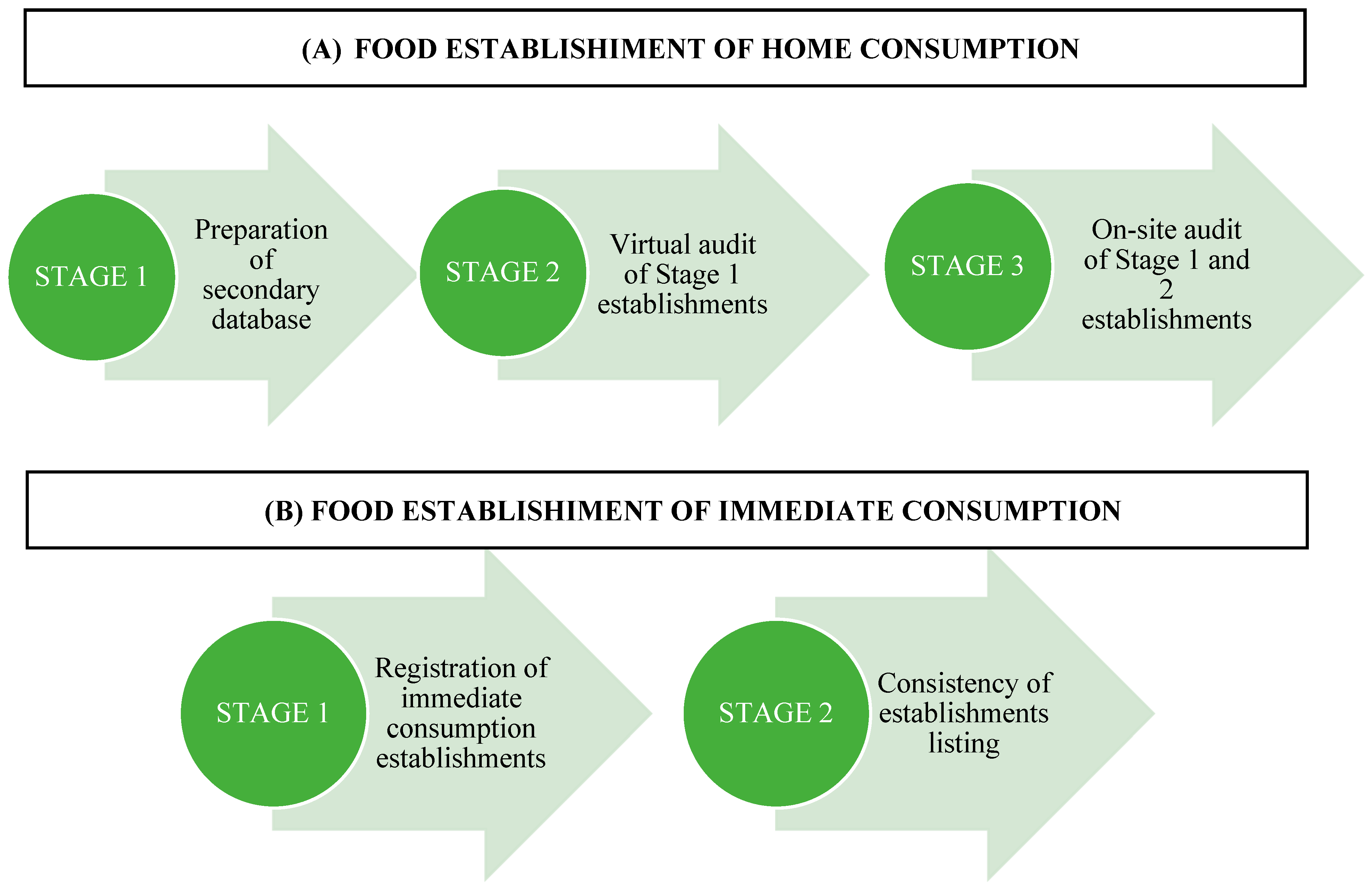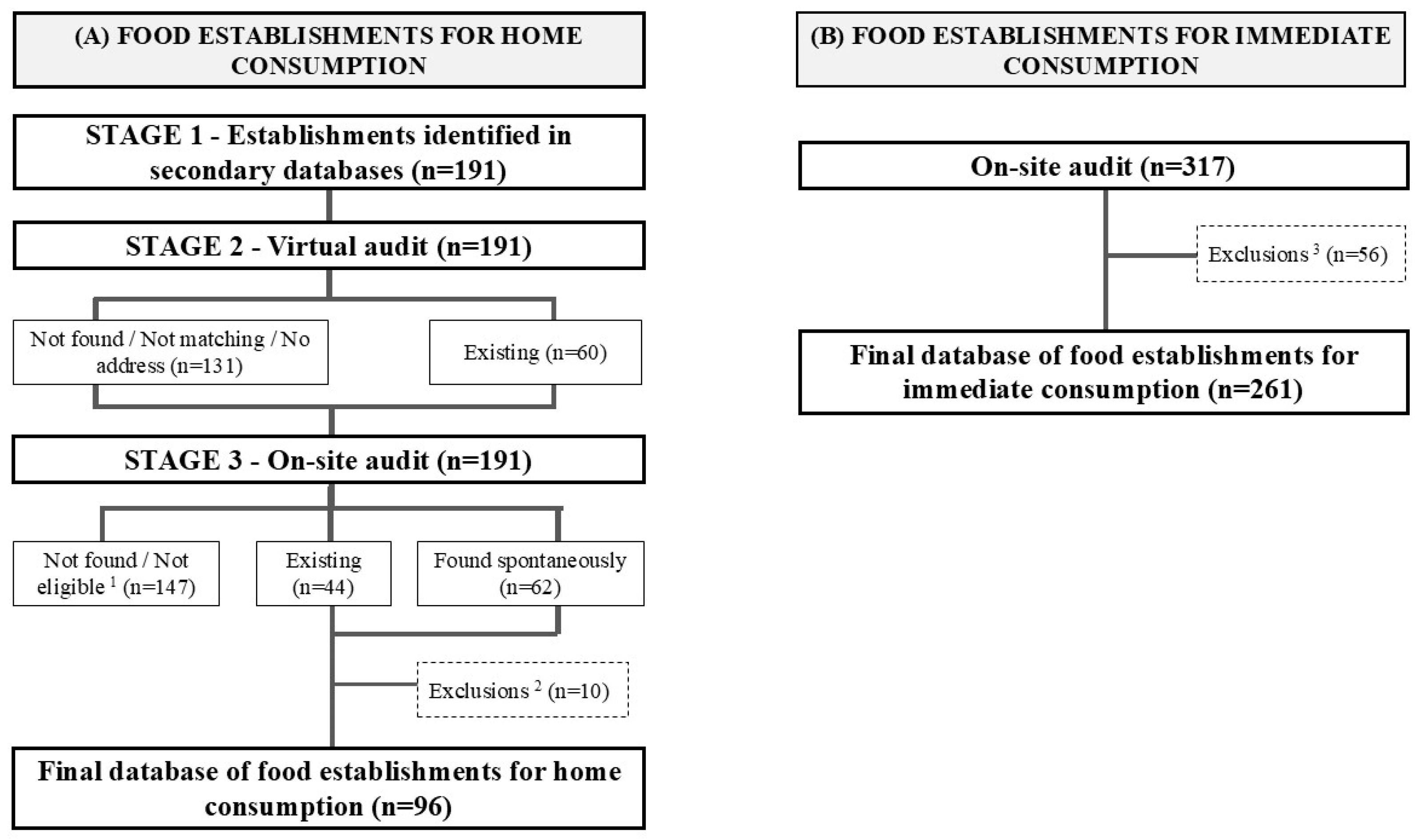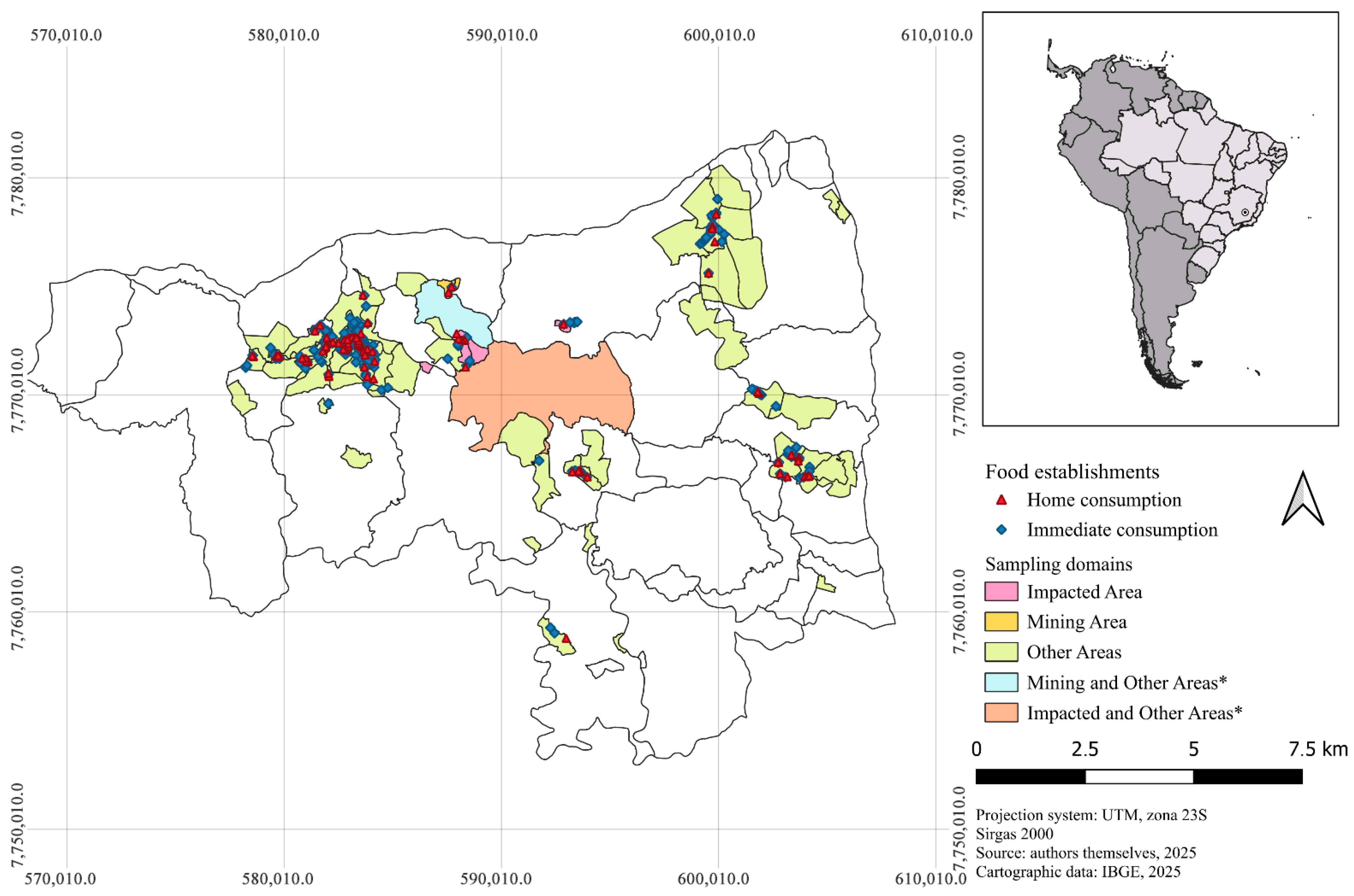Community Food Environment in Brazilian Medium-Sized Municipality After the Ore Dam Break: Database Creation and Diagnosis
Abstract
1. Introduction
2. Methods
2.1. Study Design and Setting
2.2. Data Collection
2.3. Database Construction
2.3.1. Food Retail Establishments for Home Consumption
2.3.2. Food Retail Establishments for Immediate Consumption
2.4. Data Analysis
3. Results
4. Discussion
5. Conclusions
Supplementary Materials
Author Contributions
Funding
Institutional Review Board Statement
Informed Consent Statement
Data Availability Statement
Acknowledgments
Conflicts of Interest
References
- High Level Panel of Experts (HLPE). Nutrition and food systems. In A Report by the High Level Panel of Experts on Food Security and Nutrition of the Committee on World Food Security; High Level Panel of Experts (HLPE): Rome, Italy, 2017. [Google Scholar]
- Glanz, K.; Sallis, J.F.; Saelens, B.E.; Frank, L.D. Healthy nutrition environments: Concepts and measures. Am. J. Health Promot. AJHP 2005, 19, 330–333, ii. [Google Scholar] [CrossRef]
- Downs, S.M.; Ahmed, S.; Fanzo, J.; Herforth, A. Food Environment Typology: Advancing an Expanded Definition, Framework, and Methodological Approach for Improved Characterization of Wild, Cultivated, and Built Food Environments toward Sustainable Diets. Foods 2020, 9, 532. [Google Scholar] [CrossRef]
- Swinburn, B.A.; Kraak, V.I.; Allender, S.; Atkins, V.J.; Baker, P.I.; Bogard, J.R.; Brinsden, H.; Calvillo, A.; De Schutter, O.; Devarajan, R.; et al. The Global Syndemic of Obesity, Undernutrition, and Climate Change: The Lancet Commission report. Lancet 2019, 393, 791–846. [Google Scholar] [CrossRef]
- Duran, A.C.; Diez Roux, A.V.; do Rosario, D.O.L.M.; Jaime, P.C. Neighborhood socioeconomic characteristics and differences in the availability of healthy food stores and restaurants in Sao Paulo, Brazil. Health Place 2013, 23, 39–47. [Google Scholar] [CrossRef]
- Rocha, L.L.; Carmo, A.S.D.; Jardim, M.Z.; Leme, B.A.; de Oliveira Cardoso, L.; Caiaffa, W.T.; de Souza Andrade, A.C.; dos Santos, L.C.; Mendes, L.L. The community food environment of a Brazilian metropolis. Food Cult. Soc. 2023, 26, 182–192. [Google Scholar] [CrossRef]
- Lucan, S.C. Concerning limitations of food-environment research: A narrative review and commentary framed around obesity and diet-related diseases in youth. J. Acad. Nutr. Diet. 2015, 115, 205–212. [Google Scholar] [CrossRef] [PubMed]
- Araújo MLd Silva, G.B.; Rocha, L.L.; Novaes, T.G.; de Lima, C.A.M.; Mendes, L.L.; Pessoa, M.C. Características do ambiente alimentar comunitário e do entorno das residências das famílias beneficiárias do Programa Bolsa Família. Ciênc Saúde Coletiva 2022, 27, 641–651. [Google Scholar] [CrossRef] [PubMed]
- Wilkins, E.L.; Radley, D.; Morris, M.A.; Griffiths, C. Examining the validity and utility of two secondary sources of food environment data against street audits in England. Nutr. J. 2017, 16, 82. [Google Scholar] [CrossRef] [PubMed]
- Wong, M.S.; Peyton, J.M.; Shields, T.M.; Curriero, F.C.; Gudzune, K.A. Comparing the accuracy of food outlet datasets in an urban environment. Geospat. Health 2017, 12, 546. [Google Scholar] [CrossRef] [PubMed]
- Ferreira, A.D.; Corveloni, H.F.; Boim, A.F.; Queiroz, H.M.; Souza, T.P.; Otero, X.L.; Bernardino, Â.F.; Ferreira, T.O. From tailings to tables:risk assessment of potentially toxic elements in edible crops cultivated in mine tailing impacted soils. Environ. Geochem. Health 2025, 47, 473. [Google Scholar] [CrossRef]
- Buch, A.C.; Sims, D.B.; de Ramos, L.M.; Marques, E.D.; Ritcher, S.; Abdullah, M.M.S.; Silva-Filho, E.V. Assessment of environmental pollution and human health risks of mine tailings in soil: After dam failure of the Córrego do Feijão Mine (in Brumadinho, Brazil). Environ. Geochem. Health 2024, 46, 72. [Google Scholar] [CrossRef]
- Estado de Minas Gerais. Diagnóstico Inicial de Impactos do Rompimento|MG.GOV.BR—Pró-Brumadinho. 2024. Available online: https://www.mg.gov.br/pro-brumadinho/pagina/diagnostico-inicial-de-impactos-do-rompimento-1 (accessed on 12 September 2025).
- Peixoto, S.V.; Firmo, J.O.A.; Fróes-Asmus, C.I.R.; de Melo Mambrini, J.V.; de Freitas, C.M.; Lima-Costa, M.F.; de Souza Júnior, P.R.B. Brumadinho Health Project: Methodological aspects and epidemiological profile of participants in the cohort baseline. Rev. Bras. Epidemiol. 2022, 25, e220002. [Google Scholar] [CrossRef]
- de Miranda, M.G.; Friede, R.; Dusek, P.M.; Vieira, D.M.D.N.; Avelar, K.E.S. (Eds.) Dossiê Brumadinho: Impactos do Maior Desastre Humano e Ambiental do Brasil, 1st ed.; Letra Capital: Rio de Janeiro, Brazil, 2021. [Google Scholar]
- Landis, J.R.; Koch, G.G. The measurement of observer agreement for categorical data. Biometrics 1977, 33, 159–174. [Google Scholar] [CrossRef]
- Download · QGIS Web Site. 2025. Available online: https://qgis.org/download/ (accessed on 5 November 2025).
- Farah, I.; Stern, D.; Ramírez, Y.; López-Olmedo, N.; Pérez-Ferrer, C.; A Langellier, B.; Colchero, M.A.; Barrientos-Gutierrez, T. Food and beverage purchases at formal and informal outlets in Mexico. Public Health Nutr. 2023, 26, 1034–1043. [Google Scholar] [CrossRef]
- Lucan, S.C.; Maroko, A.R.; Abrams, C.; Rodriguez, N.; Patel, A.N.; Gjonbalaj, I.; Schechter, C.B.; Elbel, B. Government data v. ground observation for food-environment assessment: Businesses missed and misreported by city and state inspection records. Public Health Nutr. 2020, 23, 1414–1427. [Google Scholar] [CrossRef]
- Burgoine, T.; Harrison, F. Comparing the accuracy of two secondary food environment data sources in the UK across socio-economic and urban/rural divides. Int. J. Health Geogr. 2013, 12, 2. [Google Scholar] [CrossRef]
- Taylor, N.G.; Stymest, J.; Mah, C.L. Validation of a province-wide commercial food store dataset in a heterogeneous predominantly rural food environment. Public Health Nutr. 2020, 23, 1889–1895. [Google Scholar] [CrossRef] [PubMed]
- de Lima Costa, B.V.; de Freitas, P.P.; de Menezes, M.C.; Guimarães, L.M.F.; de Fátima Ferreira, L.; Alves, M.D.S.C.; Lopes, A.C.S. Ambiente alimentar: Validação de método de mensuração e caracterização em território com o Programa Academia da Saúde. Cad. Saúde Públ. 2018, 34, e00168817. [Google Scholar] [CrossRef]
- da Cruz Della Torre, A.C.; Segheto, W.; Honório, O.S.; Inácio, M.L.C.; de Aguiar Toloni, M.H.; Lima, D.B. Caracterização do Ambiente Alimentar de Varejo e Identificação de Desertos e Pântanos Alimentares em um Município de médio porte no Brasil. Hygeia—Rev. Bras. Geogr. Méd. Saúde 2025, 21, e2105. [Google Scholar] [CrossRef]
- Amancio, L.S.; Schemiko, L.B.; Retondario, A. Ambiente alimentar em um território de vulnerabilidade social em Piraquara-PR. Saúde Debate 2024, 48, e8575. [Google Scholar] [CrossRef]
- Brasil. Brumadinho (MG)|Cidades e Estados|IBGE. 2024. Available online: https://www.ibge.gov.br/cidades-e-estados/mg/brumadinho.html (accessed on 12 September 2025).
- Leite, M.A.; Barata, M.F.; Levy, R.B. Ambiente alimentar próximo às escolas na maior metrópole brasileira: Análises e contribuições com base em dados censitários. Cad. Saúde Públ. 2023, 39, e00030223. [Google Scholar] [CrossRef]
- Bezerra, J.E.; Agner, M.R. Geographic Dynamics of the Supermarket Sector in Brasília (DF). Soc. Nat. 2021, 33, e59769. [Google Scholar]
- Brasil, Câmara Interministerial de Segurança Alimentar e Nutricional (CAISAN). Estudo Técnico Mapeamento dos Desertos Alimentares no Brasil. Available online: https://aplicacoes.mds.gov.br/sagirmps/noticias/arquivos/files/Estudo_tecnico_mapeamento_desertos_alimentares.pdf (accessed on 2 November 2025).
- Brasil. IBGE|Concla|Busca Online. 2025. Available online: https://concla.ibge.gov.br/busca-online-cnae.html (accessed on 19 June 2025).
- de Freitas, P.P.; Lopes, M.S.; de Menezes, M.C.; Jaime, P.C.; Lopes, A.C.S. Consumer food environments change over a 5-year period. Public Health Nutr. 2024, 27, e187. [Google Scholar] [CrossRef]
- Franco, M.; Diez-Roux, A.V.; Nettleton, J.A.; Lazo, M.; Brancati, F.; Caballero, B.; Glass, T.; Moore, L.V. Availability of healthy foods and dietary patterns: The Multi-Ethnic Study of Atherosclerosis. Am. J. Clin. Nutr. 2009, 89, 897–904. [Google Scholar] [CrossRef]
- Bridle-Fitzpatrick, S. Food deserts or food swamps?: A mixed-methods study of local food environments in a Mexican city. Soc. Sci. Med. 1982 2015, 142, 202–213. [Google Scholar] [CrossRef]
- de Freitas, C.M.; Barcellos, C.; Asmus, C.I.R.F.; Silva, M.A.; Xavier, D.R. Da Samarco em Mariana à Vale em Brumadinho: Desastres em barragens de mineração e Saúde Coletiva. Cad. Saúde Públ. 2019, 35, e00052519. [Google Scholar] [CrossRef]
- World Health Organization. Food and Nutrition in Disasters—PAHO/WHO|Pan American Health Organization. 2019. Available online: https://www.paho.org/en/health-emergencies/food-and-nutrition-disasters (accessed on 5 November 2025).
- Peixoto, S.V.; Fróes-Asmus, C.I.R. Living and health conditions after a mining dam rupture: Brumadinho Health Project and Bruminha Project. Rev. Bras. Epidemiol. 2022, 25, e220001. [Google Scholar] [CrossRef]
- Silva, L.E.A.D.; Silva, T.P.R.D.; Honório, O.S.; Inácio, M.L.C.; Mendes, L.L. Ambiente alimentar de varejo no entorno de instituições de ensino superior de uma metrópole brasileira. Rev. Bras. Epidemiol. 2025, 28, e250004. [Google Scholar]
- Barbosa, B.B.; dos Santos Penha, E.D.; Carioca, A.A.F. Food environment of the economic capital of the Northeast: Social and territorial disparities in the availability of food stores. Rev. Nutr. 2022, 35, e210060. [Google Scholar] [CrossRef]
- Justiniano, I.C.S.; de Menezes, M.C.; Mendes, L.L.; Pessoa, M.C. Retail food environment in a Brazilian metropolis over the course of a decade: Evidence of restricted availability of healthy foods. Public Health Nutr. 2022, 25, 2584–2592. [Google Scholar] [CrossRef]
- de Lima Pereira, P.M.; Neves, F.S.; Nogueira, M.C.; Cândido, A.P.C. Consumer food environment assessment and its association with socioeconomic factors in a midsize city in Brazil. Rev. Nutr. 2023, 36, e220081. Available online: https://puccampinas.emnuvens.com.br/nutricao/article/view/10467 (accessed on 19 June 2025). [CrossRef]
- Nascimento-Souza, M.A.; de Freitas, P.P.; Lopes, M.S.; Firmo, J.O.A. Consumo alimentar em participantes do Projeto Saúde Brumadinho. Rev. Bras. Epidemiol. 2022, 25, e220008. [Google Scholar] [PubMed]
- Lopes, M.S.; de Freitas, P.P.; Nascimento-Souza, M.A.; Peixoto, S.V. Projeto Saúde Brumadinho: Insegurança alimentar e nutricional versus condições socioeconômicas e dimensões do sistema alimentar após desastre. Rev. Bras. Epidemiol. 2022, 25, e220007. [Google Scholar] [CrossRef] [PubMed]




Disclaimer/Publisher’s Note: The statements, opinions and data contained in all publications are solely those of the individual author(s) and contributor(s) and not of MDPI and/or the editor(s). MDPI and/or the editor(s) disclaim responsibility for any injury to people or property resulting from any ideas, methods, instructions or products referred to in the content. |
© 2025 by the authors. Licensee MDPI, Basel, Switzerland. This article is an open access article distributed under the terms and conditions of the Creative Commons Attribution (CC BY) license (https://creativecommons.org/licenses/by/4.0/).
Share and Cite
de Freitas, P.P.; Lopes, M.S.; Ferreira, N.L.; Peixoto, S.V.; Lopes, A.C.S. Community Food Environment in Brazilian Medium-Sized Municipality After the Ore Dam Break: Database Creation and Diagnosis. Int. J. Environ. Res. Public Health 2025, 22, 1723. https://doi.org/10.3390/ijerph22111723
de Freitas PP, Lopes MS, Ferreira NL, Peixoto SV, Lopes ACS. Community Food Environment in Brazilian Medium-Sized Municipality After the Ore Dam Break: Database Creation and Diagnosis. International Journal of Environmental Research and Public Health. 2025; 22(11):1723. https://doi.org/10.3390/ijerph22111723
Chicago/Turabian Stylede Freitas, Patrícia Pinheiro, Mariana Souza Lopes, Nathália Luíza Ferreira, Sérgio Viana Peixoto, and Aline Cristine Souza Lopes. 2025. "Community Food Environment in Brazilian Medium-Sized Municipality After the Ore Dam Break: Database Creation and Diagnosis" International Journal of Environmental Research and Public Health 22, no. 11: 1723. https://doi.org/10.3390/ijerph22111723
APA Stylede Freitas, P. P., Lopes, M. S., Ferreira, N. L., Peixoto, S. V., & Lopes, A. C. S. (2025). Community Food Environment in Brazilian Medium-Sized Municipality After the Ore Dam Break: Database Creation and Diagnosis. International Journal of Environmental Research and Public Health, 22(11), 1723. https://doi.org/10.3390/ijerph22111723





